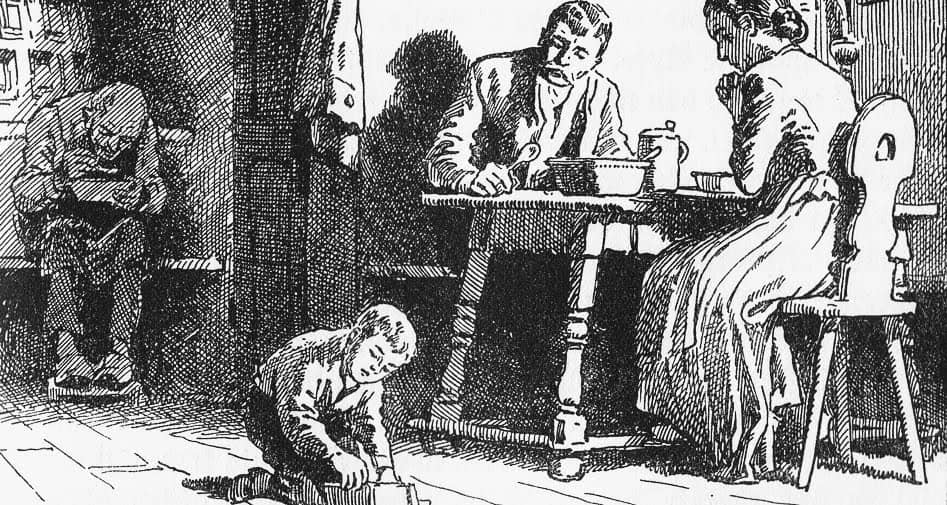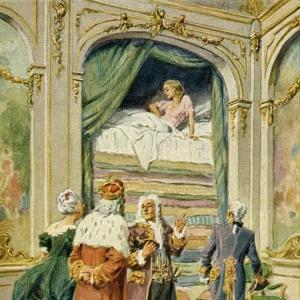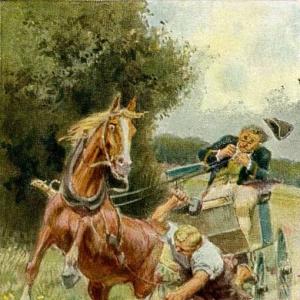Reading time: 3 min
There was once a very old man, whose eyes had become dim, his ears dull of hearing, his knees trembled, and when he sat at table he could hardly hold the spoon, and spilt the broth upon the table-cloth or let it run out of his mouth. His son and his son’s wife were disgusted at this, so the old grandfather at last had to sit in the corner behind the stove, and they gave him his food in an earthenware bowl, and not even enough of it. And he used to look towards the table with his eyes full of tears.
Once, too, his trembling hands could not hold the bowl, and it fell to the ground and broke. The young wife scolded him, but he said nothing and only sighed. Then they bought him a wooden bowl for a few half-pence, out of which he had to eat. They were once sitting thus when the little grandson of four years old began to gather together some bits of wood upon the ground. „What are you doing there?“ asked the father. „I am making a little trough,“ answered the child, „for father and mother to eat out of when I am big.“
The man and his wife looked at each other for a while, and presently began to cry. Then they took the old grandfather to the table, and henceforth always let him eat with them, and likewise said nothing if he did spill a little of anything.
 Learn languages. Double-tap on a word.Learn languages in context with Childstories.org and Deepl.com.
Learn languages. Double-tap on a word.Learn languages in context with Childstories.org and Deepl.com.Backgrounds
Interpretations
Adaptions
Summary
Linguistics
„The Old Man and his Grandson“ is a German fairy tale collected by the Brothers Grimm in their famous collection, „Grimms‘ Fairy Tales“ (originally titled „Kinder- und Hausmärchen“). Jacob and Wilhelm Grimm were German scholars, linguists, and authors who collected and published numerous folk tales and legends during the 19th century, contributing significantly to the study of folklore and the preservation of cultural heritage.
The Brothers Grimm collected stories from various sources, including oral traditions, manuscripts, and printed books. Their goal was to document and preserve the rich oral tradition of German folklore, which they believed to be an essential part of the nation’s cultural heritage. While their collection started with a focus on stories told within Germany, they eventually expanded to include tales from other European countries.
„The Old Man and his Grandson“ is a relatively short and simple tale compared to some of the other, more elaborate stories in the Grimms‘ collection. Its straightforward narrative and universal message about empathy and respect for the elderly make it an easily relatable story for readers of all ages. The tale has been retold in various forms and has inspired adaptations in literature, film, and other forms of media, demonstrating its enduring appeal and relevance.
„The Old Man and his Grandson“ can be interpreted in various ways, offering important lessons and insights into human nature and society. Here are some possible interpretations of the story.
Respect for the elderly: The story highlights the importance of treating the elderly with respect and compassion. The old man’s struggles are a natural part of aging, and his family’s initial response to his difficulties reflects a lack of understanding and empathy. However, their change in behavior illustrates that it is never too late to learn from our mistakes and treat others with kindness.
Intergenerational responsibility: The story emphasizes the importance of caring for one another across generations. The little grandson’s actions remind his parents of their duty to care for their own aging parents, just as they will need care when they grow old.
Empathy and perspective: The grandson’s innocent and honest response serves as a wake-up call for the young couple, forcing them to see their actions from a different perspective. This shift in perspective leads them to reconsider their treatment of the old man, ultimately realizing that they should be more compassionate and understanding.
The cycle of life: The tale serves as a reminder that everyone will experience the challenges of aging, and that we should be mindful of the way we treat others. The young couple realizes that their own treatment of the old man could be mirrored in their future, inspiring them to change their behavior.
The wisdom of children: The story also highlights the wisdom and insight that can come from children, even at a young age. The grandson’s innocent observation teaches his parents a valuable lesson about empathy and respect for the elderly, reminding readers that wisdom can come from unexpected sources.
„The Old Man and His Grandson“ is a well-known fairy tale, and as such, it has been adapted in various forms over the years. Here are a few examples.
Picture books: Several picture book versions of the story have been published, including adaptations by Tomie dePaola, Ruth Sanderson, and Patricia Lee Gauch. These books often feature colorful illustrations that bring the story to life for young readers.
Animated films: The story has been adapted into animated films, including a 1980s Soviet-era cartoon and a more recent adaptation by students at the Gobelins animation school in France. These adaptations often use the visual medium to emphasize the emotional impact of the story.
Stage plays: The story has been adapted into stage plays, including a 2018 production by the Dutch National Opera and Ballet. These adaptations often emphasize the theatrical elements of the story, such as character interactions and dramatic tension.
Modern retellings: The story has also been adapted into modern retellings, such as the 2019 novel „The Old Man and the Boy“ by Charles Simic, which updates the story to a contemporary setting. These adaptations often explore new themes and ideas while still remaining true to the original story.
Overall, „The Old Man and His Grandson“ is a versatile tale that lends itself well to adaptation in various forms. Its timeless themes of family, empathy, and responsibility continue to resonate with readers and audiences of all ages.
„The Old Man and his Grandson“ is a Brothers Grimm fairy tale that tells the story of an elderly man who, due to his declining health and abilities, has difficulty eating without making a mess. His son and daughter-in-law become disgusted by his struggles, eventually relegating him to the corner behind the stove, where they serve him meager portions in an earthenware bowl. The old man’s sadness is evident as he watches the family eat at the table, often with tears in his eyes.
One day, the old man accidentally drops his bowl, breaking it. His daughter-in-law scolds him, and the family replaces his bowl with a cheap wooden one. Later, they observe their four-year-old grandson gathering bits of wood on the ground. When asked what he is doing, the child replies that he is making a trough for his parents to eat from when they are old.
Upon hearing this, the son and daughter-in-law are deeply affected and begin to cry. Realizing their mistreatment of the old man, they bring him back to the table, allowing him to eat with them without comment, even if he spills some food. The story conveys the importance of compassion and empathy towards the elderly, reminding us to treat them with dignity and respect.
The fairy tale „The Old Man and his Grandson“ by the Brothers Grimm offers rich material for linguistic analysis, particularly in its stylistic simplicity, use of direct speech, and social commentary embedded within its narrative structure.
Stylistic Simplicity: The narrative is characterized by a straightforward, unembellished style typical of many folktales. The sentences are generally simple, employing basic structures that make the story accessible to a wide audience. There’s a focus on plainly describing the old man’s condition and the family dynamics, which effectively sets up the moral message of the story.
Direct Speech: The use of direct speech is a significant feature, serving both as a narrative device and as a means to convey character motivations and emotions. For example, the dialogue between the father and the young child is pivotal. The child’s innocent declaration about making a trough highlights his keen observation and understanding of fairness and respect, despite his young age. This use of direct speech allows readers to engage directly with the characters’ realizations and emotions.
Repetition and Parallelism: The narrative employs repetitive and parallel structures, particularly in the depiction of the old man’s frailty and the family’s growing impatience. This repetition serves to emphasize the ongoing nature of the mistreatment and the resulting sadness of the grandfather, thus enhancing the reader’s empathy.
Symbolism: The broken earthenware bowl and the wooden trough are symbolic within the linguistic economy of the tale. The bowl represents the old man’s perceived worth and the value (or lack thereof) that the family places on him. The trough, on the other hand, symbolizes a karmic return to the parents, provoking a sudden realization about their behavior and its potential consequences.
Moral Lesson: Linguistically, the narrative is designed to lead the audience to a clear moral lesson about respect and empathy for the elderly. The child’s simple act and statement are the catalysts for change, relying on the language of innocence to impart a powerful message about how we treat our elders.
Emotional Tone: The language is imbued with an emotional tone, particularly highlighted by the old man’s tears and the parents‘ eventual crying. This use of emotive language directly engages the reader’s feelings and highlights the transformation from insensitivity to empathy.
Through these linguistic features, the tale effectively communicates its themes of empathy, respect, and intergenerational relationships, leveraging its simple language to leave a lasting impression on the reader.
Information for scientific analysis
Fairy tale statistics | Value |
|---|---|
| Number | KHM 78 |
| Aarne-Thompson-Uther-Index | ATU Typ 980 |
| Translations | DE, EN, DA, ES, FR, PT, IT, JA, NL, PL, RO, RU, TR, VI, ZH |
| Readability Index by Björnsson | 28.5 |
| Flesch-Reading-Ease Index | 82.1 |
| Flesch–Kincaid Grade-Level | 7 |
| Gunning Fog Index | 9.8 |
| Coleman–Liau Index | 7.2 |
| SMOG Index | 8.2 |
| Automated Readability Index | 7.4 |
| Character Count | 1.276 |
| Letter Count | 981 |
| Sentence Count | 12 |
| Word Count | 251 |
| Average Words per Sentence | 20,92 |
| Words with more than 6 letters | 19 |
| Percentage of long words | 7.6% |
| Number of Syllables | 307 |
| Average Syllables per Word | 1,22 |
| Words with three Syllables | 9 |
| Percentage Words with three Syllables | 3.6% |

 Facebook
Facebook  Whatsapp
Whatsapp  Messenger
Messenger  Telegram
Telegram Reddit
Reddit














